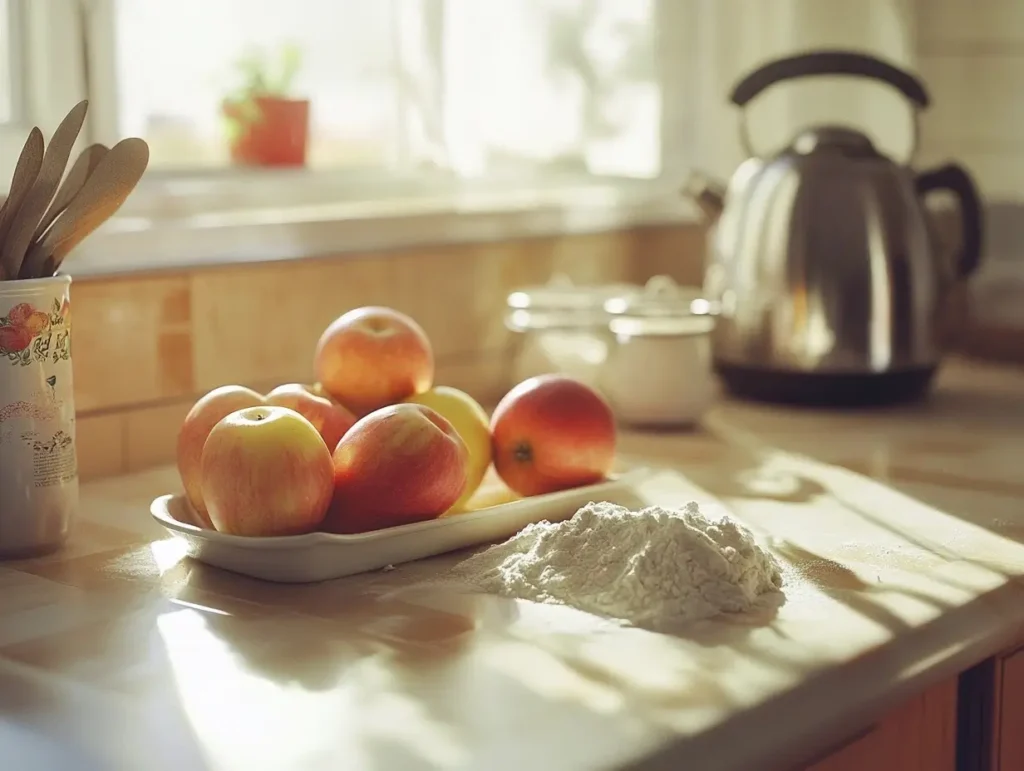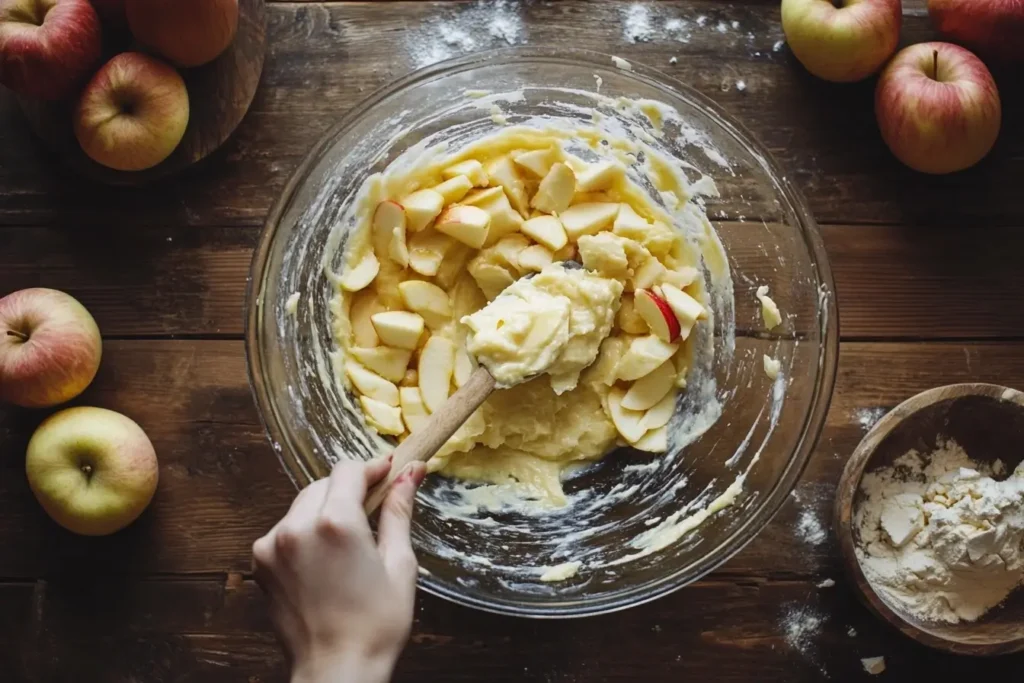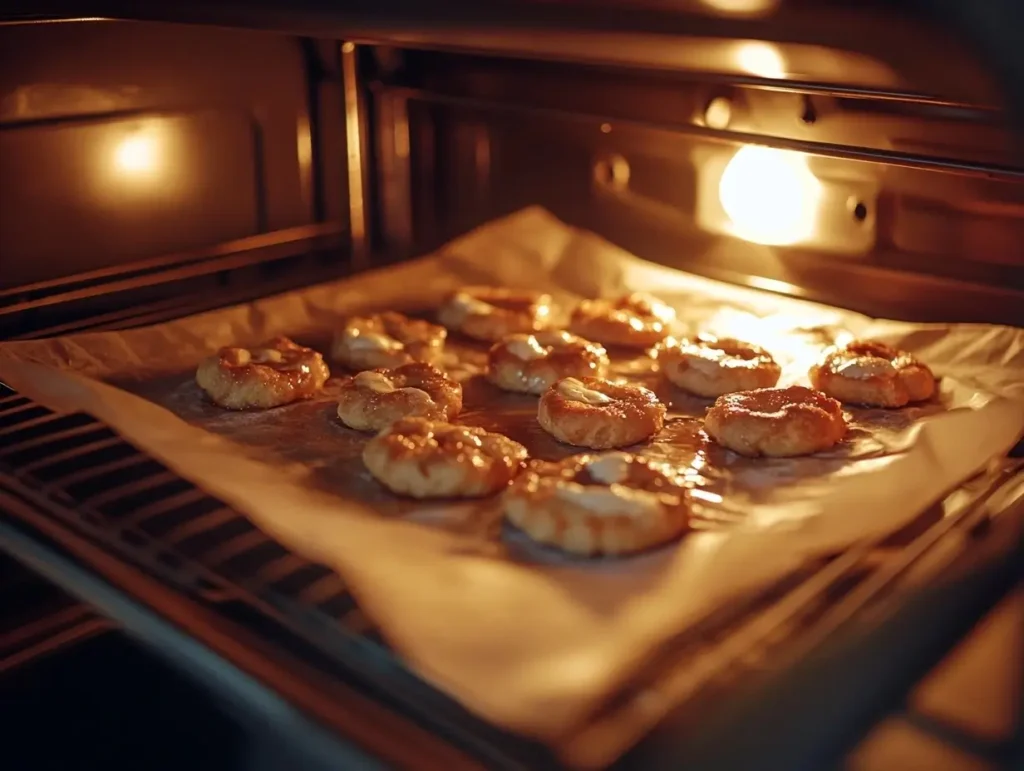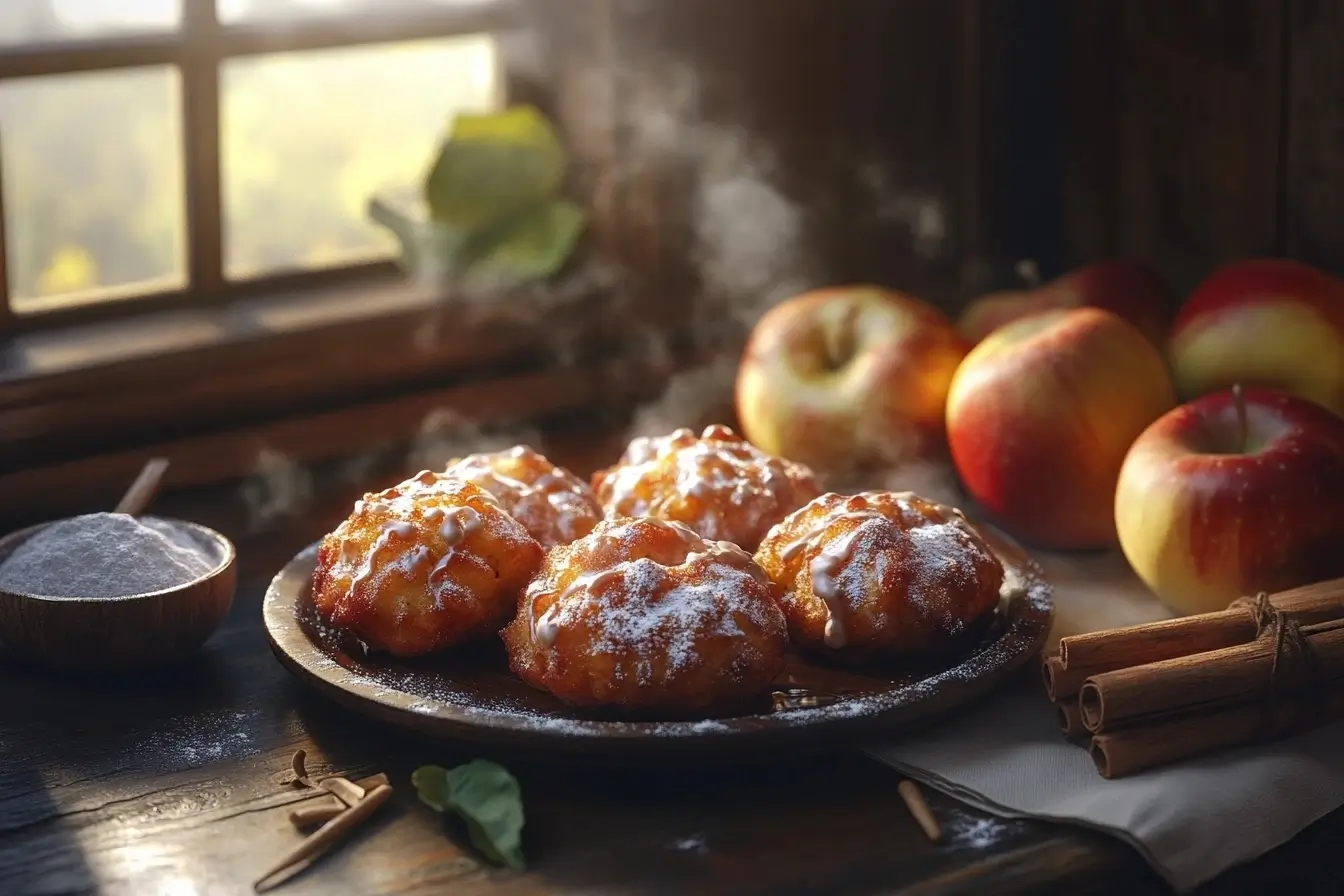Apple fritters are a classic dessert loved for their sweet and tangy apple filling and soft, doughy texture. But did you know you can skip frying and bake them instead? Baking apple fritters is a healthier, mess-free alternative, and with the right steps, you can whip up a batch that’s just as crispy and golden. This article breaks down exactly how to bake apple fritters with easy-to-follow steps, tips, and variations to suit your taste. So, tie on your apron and let’s start this sweet journey!
What Are Apple Fritters?
Brief History and Cultural Significance
Apple fritters have a rich history that spans centuries and cultures. Originating as a way to use surplus apples during harvest, they quickly became a beloved treat around the globe. In the United States, apple fritters are often associated with fairs and home baking traditions, evoking feelings of comfort and nostalgia. Similarly, in European countries, fritters are a staple during festive seasons, each region adding its unique spin. Their universal appeal lies in their simplicity—sweet apples wrapped in tender dough, baked or fried to perfection.
Why Apple Fritters Are a Popular Dessert
Apple fritters are celebrated for their irresistible combination of flavors and textures. The natural sweetness of fresh apples, combined with the warmth of cinnamon and nutmeg, creates a taste that’s hard to beat. Their versatility also makes them a go-to treat; they can be enjoyed plain, glazed, or even with a drizzle of caramel. Whether as a quick snack, dessert, or breakfast companion, these fritters have a way of satisfying cravings across all ages. For detailed steps and expert tips, check out How to Make Perfect Baked Apple Fritters: A Healthier Twist on a Classic Treat.
Why Bake Instead of Fry?
Health Benefits of Baked vs. Fried Fritters
Choosing to bake apple fritters instead of frying them is a win for your health. Baked fritters are naturally lower in fat and calories because they skip the oil bath that frying requires. This makes them a lighter option without compromising on flavor or texture. Moreover, they’re perfect for people looking to enjoy their favorite desserts without feeling guilty about indulgence.
Environmental Advantages of Baking
Beyond health perks, baking is also a more sustainable option. Frying often requires large amounts of oil, which can be wasteful and difficult to dispose of responsibly. Baking, on the other hand, uses minimal resources and produces less mess. It’s cleaner, greener, and more efficient for home cooks. Plus, it’s one less thing to clean up after you’ve enjoyed your delicious fritters!
Essential Ingredients for Baking Apple Fritters
Flour, Sugar, and Spices
The foundation of any good apple fritter starts with simple pantry staples. All-purpose flour provides the structure, while sugar adds the sweetness that complements the tartness of the apples. Spices like cinnamon and nutmeg bring warmth and depth, creating that unmistakable fritter flavor. You can even sprinkle a bit of allspice or cardamom for a subtle twist.
Fresh Apples: Recommended Varieties
The star ingredient, apples, play a critical role in the texture and taste of your fritters. Granny Smith apples are a favorite because their tartness balances the sweetness of the batter. Honeycrisp apples, on the other hand, add a naturally sweet and crisp bite, while Fuji apples are perfect for a milder flavor. Whichever you choose, make sure the apples are fresh and firm to hold up during baking.
Eggs, Butter, and Baking Powder
Eggs add moisture and help bind the ingredients together, ensuring your fritters don’t fall apart. Butter provides richness, making the dough tender and flavorful. Baking powder acts as the leavening agent, giving the fritters their light, airy texture. These ingredients work together to create the perfect base for your fritters.

Optional Ingredients and Substitutions
Dairy-Free and Gluten-Free Alternatives
For a dairy-free option, you can substitute butter with coconut oil or vegan margarine and use plant-based milk instead of regular milk. If you’re gluten-sensitive, swap the all-purpose flour for a 1:1 gluten-free flour blend.
Adding Nuts, Raisins, or Other Fruits
Want to add a bit of crunch? Chopped walnuts or pecans work beautifully. For extra sweetness, mix in raisins, dried cranberries, or even diced pears. These additions can make your fritters even more unique and personalized.
Prepping Your Ingredients
How to Dice and Season Apples for Maximum Flavor
Properly prepping the apples ensures they shine in every bite. Start by peeling and dicing the apples into small, evenly-sized cubes—this helps them cook evenly. Toss the diced apples with a sprinkle of sugar and a dash of cinnamon to enhance their natural sweetness. If you like a hint of tartness, add a squeeze of lemon juice. Let the apples sit for 10–15 minutes before adding them to the batter to allow the flavors to meld beautifully.
Step-by-Step Guide: How to Bake Apple Fritters
Mixing Dry and Wet Ingredients Correctly
To achieve that perfect fritter texture, it’s crucial to mix the ingredients in the right order. First, combine the dry ingredients in a large mixing bowl: flour, sugar, cinnamon, nutmeg, and baking powder. Next, whisk them together thoroughly to ensure the leavening agent is distributed evenly. Meanwhile, in a separate bowl, whisk the wet ingredients—eggs, melted butter, and milk—until the mixture becomes smooth and well combined. After that, gradually add the wet mixture into the dry ingredients. As you do this, fold the batter gently to avoid overmixing, which can make the fritters dense. By following these steps carefully, you’ll achieve a batter that is light and ready for baking.

Ensuring a Lump-Free, Airy Batter
A batter that’s too lumpy will leave pockets of dry flour, while overmixing can make your fritters dense. The key is to stir just until combined; a few small lumps are fine. Finally, fold in your seasoned apples carefully to ensure they’re evenly distributed without deflating the batter.
Preparing the Baking Tray
Lining with Parchment Paper or Greasing Alternatives
For easy cleanup and a non-stick surface, start by lining your baking tray with parchment paper when learning how to bake apple fritters. If that’s not available, however, greasing the tray with butter or a neutral oil is a reliable alternative. How to bake apple fritters successfully also depends on ensuring the greasing layer is even and light. This helps prevent sticking while avoiding any excess grease that could interfere with the fritters’ texture. Ultimately, whether you use parchment paper or grease, this step is essential in how to bake apple fritters for smooth baking and cleanup. By following this method, you’ll be well-prepared for the next stage of how to bake apple fritters!
Shaping the Fritters for Uniform Baking
Use a large spoon or ice cream scoop to drop dollops of batter onto the prepared tray. Leave enough space between each fritter to allow them to spread slightly during baking. To shape them more uniformly, gently flatten the batter with the back of your spoon. This step ensures even baking and makes your fritters look extra polished.

Baking Instructions for Oven-Baked Apple Fritters
Preheating the Oven to the Right Temperature for Easy Apple Fritters Recipes
Set your oven to 375°F (190°C) to create the ideal baking environment for homemade fritters with apples. Proper preheating is essential to ensure even cooking, so the fritters come out perfectly golden without overbrowning. A consistent oven temperature prevents the batter from drying out while allowing the fritters to bake evenly.
Recommended Baking Time for Baked Apple Desserts and Tips for Doneness
Once the oven is ready, bake the easy apple fritters for 15–20 minutes. Keep an eye on them as they bake—the edges should turn a lovely golden hue. To check if they’re done, insert a toothpick into the center of a fritter. If it comes out clean or with a few crumbs (but no wet batter), they’re ready!
If the fritters are browning too quickly, tent them with aluminum foil to protect the tops while allowing the centers to cook through. After baking, let the oven-baked apple fritters cool for 5 minutes before transferring them to a wire rack to maintain their texture.
Optional Glazing Techniques for Homemade Fritters with Apples
How to Make a Simple Sugar Glaze for Baked Apple Desserts
A sugar glaze adds a delightful sweetness and enhances the presentation of your baked apple desserts. To make it, whisk together 1 cup of powdered sugar with 2–3 tablespoons of milk or water until smooth. Drizzle the glaze over the fritters while they’re slightly warm so it spreads evenly and creates a beautiful glossy finish.
Adding Cinnamon or Maple Syrup to Boost Flavor
Take your glaze up a notch by mixing in a pinch of cinnamon or a teaspoon of maple syrup. These simple additions perfectly complement the warm spices and fruity apple notes in the fritters, creating a treat that’s irresistible. Whether you choose a classic sugar glaze or a spiced variation, your easy apple fritters recipes will taste even more delicious!
Secrets to Perfect Texture
Ensuring the Right Moisture Balance
The texture of a perfect apple fritter lies in balancing moisture. Too much moisture can make the fritters soggy, while too little can leave them dry and crumbly. To achieve the ideal consistency, be mindful of the apples’ water content. After dicing the apples, pat them dry with a paper towel to remove excess moisture. Additionally, avoid overloading the batter with apples—it can make the fritters heavy and unevenly baked.
Choosing the Best Apples for Sweetness and Tartness
Picking the right apples is critical. As mentioned earlier, Granny Smith apples are ideal for their tartness, which balances the sweetness of the batter. If you prefer a sweeter bite, Honeycrisp or Fuji apples are great choices. Mixing apple varieties can also provide a more complex flavor profile, blending sweetness and tartness for a perfectly balanced fritter.
Flavor Enhancements
Incorporating Spices for a Richer Taste
Spices are the secret to making your apple fritters truly irresistible. Cinnamon is a classic addition, but adding a pinch of nutmeg or ground cloves can elevate the flavor. If you’re feeling adventurous, a small dash of ginger adds a subtle warmth that complements the apple’s natural sweetness. Remember to mix the spices evenly into the dry ingredients to ensure every bite is packed with flavor.
How to Avoid a Bland or Overly Sweet Fritter
To prevent bland fritters, don’t shy away from seasoning the apples before adding them to the batter. A sprinkle of sugar and cinnamon can make a world of difference. On the flip side, to avoid overly sweet fritters, reduce the sugar in the batter slightly if your apples are naturally very sweet. Taste-testing the apples beforehand helps you adjust the sugar levels accordingly.
Troubleshooting Baking Issues
Why Fritters May Turn Out Dense or Dry
Dense or dry fritters can be a disappointment, but they’re a common issue with a few easy fixes. Overmixing the batter is the main culprit behind dense fritters—it develops the gluten in the flour too much, leading to a chewy texture. To prevent this, fold the batter gently and stop as soon as the ingredients are combined.
Dry fritters, on the other hand, often result from too little moisture in the batter or overbaking. Ensure your apples are juicy and your wet-to-dry ingredient ratio is correct. Adding an extra tablespoon of milk or a small dollop of yogurt can provide additional moisture without affecting the consistency too much.
Tips to Avoid Undercooked Centers
Undercooked fritters can be a letdown. The key to even baking is maintaining a consistent oven temperature and shaping the fritters uniformly. If your fritters are thick, lower the oven temperature slightly and extend the baking time by a few minutes. Always test for doneness by inserting a toothpick into the center—it should come out clean or with a few crumbs, but no wet batter.
How to Salvage Overbaked Fritters
Quick Fixes for Dryness (e.g., Syrups or Fillings)
If your fritters turn out too dry, don’t worry—they’re not beyond saving! Drizzle a warm sugar glaze over them to restore moisture and sweetness. Another trick is to pair the fritters with a dip, such as vanilla yogurt, whipped cream, or a dollop of apple butter.
For an extra decadent fix, slice the fritters in half and spread a thin layer of caramel or fruit preserves inside. This not only adds moisture but also enhances the overall flavor, making the fritters taste as though they were meant to be that way!
Calorie Breakdown
Average Calories Per Serving
Baked apple fritters are not just a delicious treat—they’re a slightly lighter alternative to their fried counterparts. On average, a baked apple fritter contains approximately 180–220 calories per serving, depending on the ingredients and portion size. Adding a glaze or extra toppings will slightly increase the calorie count but can still be part of a balanced indulgence.
Health Benefits of Ingredients
Nutritional Value of Apples and Cinnamon
The ingredients in apple fritters are not just delicious—they’re packed with surprising health benefits. Apples, for instance, are high in fiber, which aids digestion, and rich in vitamin C, which supports a healthy immune system. Cinnamon is known for its antioxidant properties and may help regulate blood sugar levels while reducing inflammation. To learn more about the benefits of these ingredients, you can visit Healthline’s guide to apple nutrition and benefits.
| Ingredient | Nutritional Benefit | Calories (Approx.) Per Serving |
|---|---|---|
| Apples (1 cup) | High in fiber, vitamin C, and natural antioxidants | 65 |
| All-Purpose Flour | Provides energy through carbohydrates | 90 |
| Cinnamon (1 tsp) | Antioxidant-rich, supports blood sugar regulation | 6 |
| Sugar (2 tbsp) | Adds sweetness, but should be consumed in moderation | 90 |
| Butter (1 tbsp) | Adds richness and a source of healthy fats | 102 |
| Egg (1 large) | Provides protein, vitamins B2 and B12 | 70 |
By incorporating wholesome ingredients like apples and cinnamon, baked apple fritters not only satisfy your sweet tooth but also offer subtle nutritional benefits. In the next section, we’ll explore exciting variations of this classic treat!
Popular Regional Variations
Dutch Apple Fritters (Oliebollen)
In the Netherlands, apple fritters are known as Oliebollen. These traditional treats are slightly different from their American counterparts, often incorporating raisins or currants into the batter. While they’re typically fried, you can adapt the recipe to baking for a lighter twist. Dutch fritters are a beloved holiday treat, particularly during New Year celebrations, served warm with a dusting of powdered sugar.
American vs. European Baking Styles
American apple fritters tend to focus on bold, sweet flavors, often featuring cinnamon and a sugary glaze. In contrast, European versions lean toward subtlety, showcasing the natural tartness of apples. While both styles are delicious, baked versions allow the flavors of fresh apples and warm spices to shine without being overshadowed by heavy oils or excessive sweetness.
Flavor Twists
Apple and Cranberry Fritters
Adding cranberries to your apple fritters introduces a delightful tartness that balances the sweet batter. These fritters are especially festive, making them perfect for autumn or holiday baking. You can use fresh or dried cranberries, but if using dried, soak them briefly in water or apple juice to plump them up before mixing.
Chocolate-Drizzled Apple Fritters
For a decadent twist, drizzle melted dark or milk chocolate over your baked fritters. The rich chocolate pairs beautifully with the fruity apple filling, creating a dessert that feels indulgent but is still lighter than fried options.
Healthy Variations
Using Whole Wheat Flour or Alternative Sweeteners
To make apple fritters healthier, substitute all-purpose flour with whole wheat flour. This swap adds fiber and a slightly nutty flavor to the fritters. For a lower-sugar option, replace refined sugar with natural sweeteners like honey, maple syrup, or coconut sugar. These small changes can make a big difference in creating a dessert that’s both delicious and nourishing.
How to Store Homemade Fritters with Apples
Best Storage Containers for Baked Apple Desserts
To keep your oven-baked apple fritters fresh and delicious, proper storage is key. Use an airtight container to maintain their moisture and prevent them from drying out. If you plan to enjoy these homemade fritters with apples within one to two days, store them at room temperature in a cool, dry place. For longer storage, refrigerate the fritters to extend their shelf life. When you’re ready to eat, let them return to room temperature for the best texture and flavor.
Reheating Baked Apple Desserts Without Losing Texture
Oven vs. Microwave Reheating Methods for Easy Apple Fritters
Reheating easy apple fritters recipes can be tricky if you want to keep their soft interior and slightly crisp exterior. The oven is your best friend here—place the fritters on a baking tray and warm them at 350°F (175°C) for 5–7 minutes to restore their just-baked goodness.
If you’re in a hurry, the microwave works too, but use caution. Heat the fritters in 10-second bursts, covering them with a damp paper towel to retain moisture. This method works well for baked apple desserts but may soften the texture slightly.
Pairing Oven-Baked Apple Fritters
Drinks and Desserts That Complement Homemade Fritters with Apples
Make apple fritters even more delightful by pairing them with the right beverages and desserts. A steaming cup of coffee or chai tea highlights the warm spices in the fritters, while spiced apple cider doubles down on the apple flavor for a cozy combo. For dessert pairings, consider serving them with a scoop of vanilla ice cream or a dollop of whipped cream for a creamy contrast that enhances the fritters’ fruity goodness.
Creative Ways to Present Easy Apple Fritters Recipes
Styling Apple Fritters for Parties or Special Occasions
Showcase your baked apple desserts with an eye-catching presentation. Arrange them on a decorative platter, drizzled with a sugar or chocolate glaze, and garnish with powdered sugar or a cinnamon stick. For a buffet-style setup, stack your homemade fritters with apples in a tiered display, offering small dipping bowls of caramel, maple syrup, or vanilla sauce to elevate their appeal. Whether for brunch or a casual gathering, these small touches make your easy apple fritters recipes truly unforgettable.
Frequently Asked Questions
Can I Use Other Fruits Besides Apples?
Absolutely! While apples are the classic choice, you can experiment with other fruits like pears, peaches, or even berries. Keep in mind that fruits with higher water content, such as strawberries, might require additional adjustments to the batter to avoid excessive moisture.
Can I Bake Apple Fritters?
Yes, you can! Baking apple fritters is a fantastic alternative to frying. It’s healthier, less messy, and still delivers the same delicious flavor. Follow a recipe specifically for baked fritters to get the best texture and consistency.
Can You Bake Apple Fritters Instead of Frying?
Definitely! Baking fritters instead of frying not only reduces fat content but also simplifies the cooking process. Just shape the batter, place it on a parchment-lined tray, and bake at 375°F (190°C) for golden, delicious results. For more insights and a detailed comparison, check out Can You Bake Apple Fritters Instead of Frying? A Healthier Alternative.
Does Baking Soda Make Fritters Crispy?
Baking soda can contribute to a light and airy texture, but crispiness comes primarily from the cooking method. Since baked fritters don’t have the same oil-based frying process, they’re less likely to be crispy but still soft and flavorful. For a detailed explanation of how baking soda affects fritter crispiness, visit Does Baking Soda Make Fritters Crispy? A Complete Guide.
Why Are My Fritters Not Crispy?
If your fritters lack crispiness, it could be due to a batter that’s too wet or a low oven temperature. For baked fritters, focus on achieving a light texture rather than crispiness, as frying is typically what gives fritters their crunch.
Why Are My Fritters Raw in the Middle?
Raw centers often result from fritters being too thick or the oven not being hot enough. Spread the batter thinly and bake at the recommended temperature. Always test with a toothpick before removing them from the oven to ensure they’re fully cooked.
Why Did My Apple Fritters Get Soggy?
Sogginess can occur if the fritters are not stored properly. Let them cool completely before storing to avoid trapping steam, which can make them wet. Using parchment paper to separate layers in the container can also help maintain their texture. If you’ve struggled with this problem, check out Why Did My Apple Fritters Get Soggy? Causes and Fixes Explained for detailed solutions and tips to keep your fritters crispy every time.
Conclusion
Baking apple fritters is a wonderful way to enjoy a timeless treat with a healthier twist. From selecting the right apples to mastering the batter, every step in how to bake apple fritters contributes to creating a dessert that’s soft, flavorful, and satisfying. Whether you’re keeping it simple with a sugar glaze, experimenting with fruity variations, or perfecting your storage and reheating methods, there’s no end to the ways you can make this recipe your own.
Remember, the joy of how to bake apple fritters isn’t just in the result but in the process—mixing ingredients, filling your home with the scent of warm apples and spices, and sharing your creation with loved ones. With the tips and techniques shared in this guide, you’re all set to bake apple fritters that will impress and delight every time. If you’ve ever wondered how to bake apple fritters successfully, this guide ensures your success. So, tie on your apron, preheat that oven, and embrace the joy of baking!
Happy baking, and may your kitchen be filled with the sweet aroma of freshly baked apple fritters!

